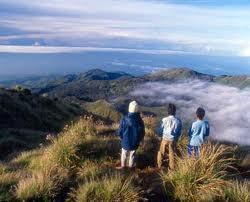History
Spanish influence was hardly felt in Davao until 1848, when an expedition of 70 men and women led by Don Jose Cruz de Uyanguren, a native of Vergara, Guipuzcoa, Spain, came to establish a Christian settlement in an area of mangrove swamps that is now Bolton Riverside. Davao was then ruled by a chieftain, Datu Bago, who held his settlement at the banks of Davao River (once called Tagloc River by the Bagobos). After Uyanguren defeated Datu Bago, he renamed the region Nueva Guipuzcoa and founded the town Nueva Vergara, which was Davao, in the year 1848, in honor of his home in Spain, and became its first governor. He himself was reported to have peaceful conquest of the entire venture. He attempted to make peace with the neighboring tribes - the Bagobos, Mansakas, Manobos, Aetas, etc. - to urge them to help develop the area; his efforts to develop the area, however, did not prosper.
A few years after the American forces landed in 1900, private farm ownership grew and transportation and communication facilities were improved, thus paving the way for the region's economic growth. During the early years of American rule which began in late December 1898 the town began to mark its roles as a new growth center of the Philippines, which it will be a city for the next 38 years. The American settlers, mostly retired soldiers and investors friends for Zamboanga, Cebu, Manila and the U.S. mainland immediately recognized the rich potential of the region for agricultural investment.
Davao City is typhoon-free due to its location. The city enjoys a weather that remains balmly all year round. It is characterized by a uniform distribution of rainfall, temperature, humidity, and air pressure. It has no pronounced wet or dry season. Weather predictability makes it highly conducive to agricultural production. Temperature ranges from 20 to 32 degrees Celsius and average rainfall is up to 2,000mm yearly.
Accessibility:
Davao City is very accessible and is the gateway to the Brunei-Indonesia-Malaysia-Philippines East Asia Growth Area or BIMP-EAGA.
By Land: Davao City also offers a wide bus network connection to major cities and provinces, not only in Mindanao but even as far as Manila and Pasay City in Luzon. Davao City is connected to Manila by a series of roll on roll off or inter-island ferry connection. Davao City is accessible by bus to and from points in Mindanao like Cotabato, Monkayo, Kidapawan, Midsayap, Digos, General Santos, Koronadal, Isulan, Tacurong, Tagum, Cagayan de Oro, Surigao, Butuan, and with Manila in Luzon.
By sea: The city is also served by domestic passenger ferries at Sasa Port and Sta. Ana Wharf.
* Sulpicio Lines twice weekly from Manila.
* SuperFerry twice weekly to Manila.
By air: Davao City has direct flights to major cities in the Philippines and some Asian Cities. Francisco Bangoy Internation Airport (Davao International Airport) is currently being served by the following airline carriers:
* Airphil Express flies to Manila 16 times weekly, Cebu twice daily, Zambaonga four times weekly, thrice weekly to Iloilo City and Cagayan de Oro, once daily.
* Cebu Pacific 4 flights weekly to Cagayan de Oro, 5 daily flights to Cebu City, 2 daily flights to Iloilo City, 8 daily flights to Manila, and Once daily flight to Zambaonga City.
*SilkAir 5 flights weekly to Singapore.
*Zest Airways 2 daily flights to Manila.
* Tiger Airways thrice weekly flights to Singapore.
*Camp Domingo Leonot - Quarters of the Spanish and later American soldiers in the 1920s. (San Pedro St.)
*City Hall of Davao - The former municipal building constructed in 1926. (San Pedro St.)
*Crocodile Farm - The only crocodile park in the region provides home to locally bred crocodiles including the country's biggest crocodile named Pangil (or fangs) measuring 18feet (5.5m) in length. On display are also dozens of species of birds and snakes, as well as tigers and great apes. One can take pleasure from viewing, horseback riding around the park, or feeding the young fierce reptiles.
*Davao Historical Society Musuem - Features the historical and indigenous collections of the Davao Historical Society (Magsaysay Park).
*DECA Wakeboard Park - Considered to the the biggest wake boarding park in the Philippines, offering the best venue for the extreme water sports, the wake-boarding and water-ski. The park also offers a scenic view of Mt. Apo that boosts amusement while riding.
*Fort Datu Bago - Site of the bastion of the Muslim hero Datu Bago who lorded over the Tagloc River, the old name of Davao River.
*Furukawa Plantation
*Gap Farm
*Gumamela Caverock Farm Resort
*J.K. Mercado Corporation
*Japanese Musuem
*Japanese Peace Memorial Shrine
*Japanese Tunnel
*Lon Wa Buddhist Temple
*Memorial to a Brave Son
*Mindanao Taoist Temple
*Mintal Historical Marker
*Monument of Peace & Unity
*Mosques
*Museo Dabawenyo
*Old Japanese Houses
*Osmena Park
*Ottha Kyosaburu Memorial Shrine
*Uyanguren Landing Site
*San Pedro Cathedral
*Shrine of the Holy Infant Jesus of Prague
*St. Mary of Perpetual Rosary
*Talomo Beach
*Eden Nature Park
*Malagos Garden Resort
*Philippine Eagle Center
*People's Park
*River Rafting at Davao River
Festival
Kadayawan Festival
Disclaimer:
Some information, images, and videos being used on PhilsTravelGuide.blogspot.com are readily available in different website links on the world wide web and believed to be in public domain. As such, contents used in our articles are believed to be posted within our rights according to the U.S. Copyright Fair Use Act (title 17, U.S. Code).
All images, videos, and information used in this site are copyright of their respective owners.
PhilsTravelGuide claims no credit for them unless otherwise noted. If you believe that any content appearing on PhilsTravelGuide infringes on your copyright and do not wish them to appear on the site, please contact us and the infringing material will be removed immediately. Thank you.









